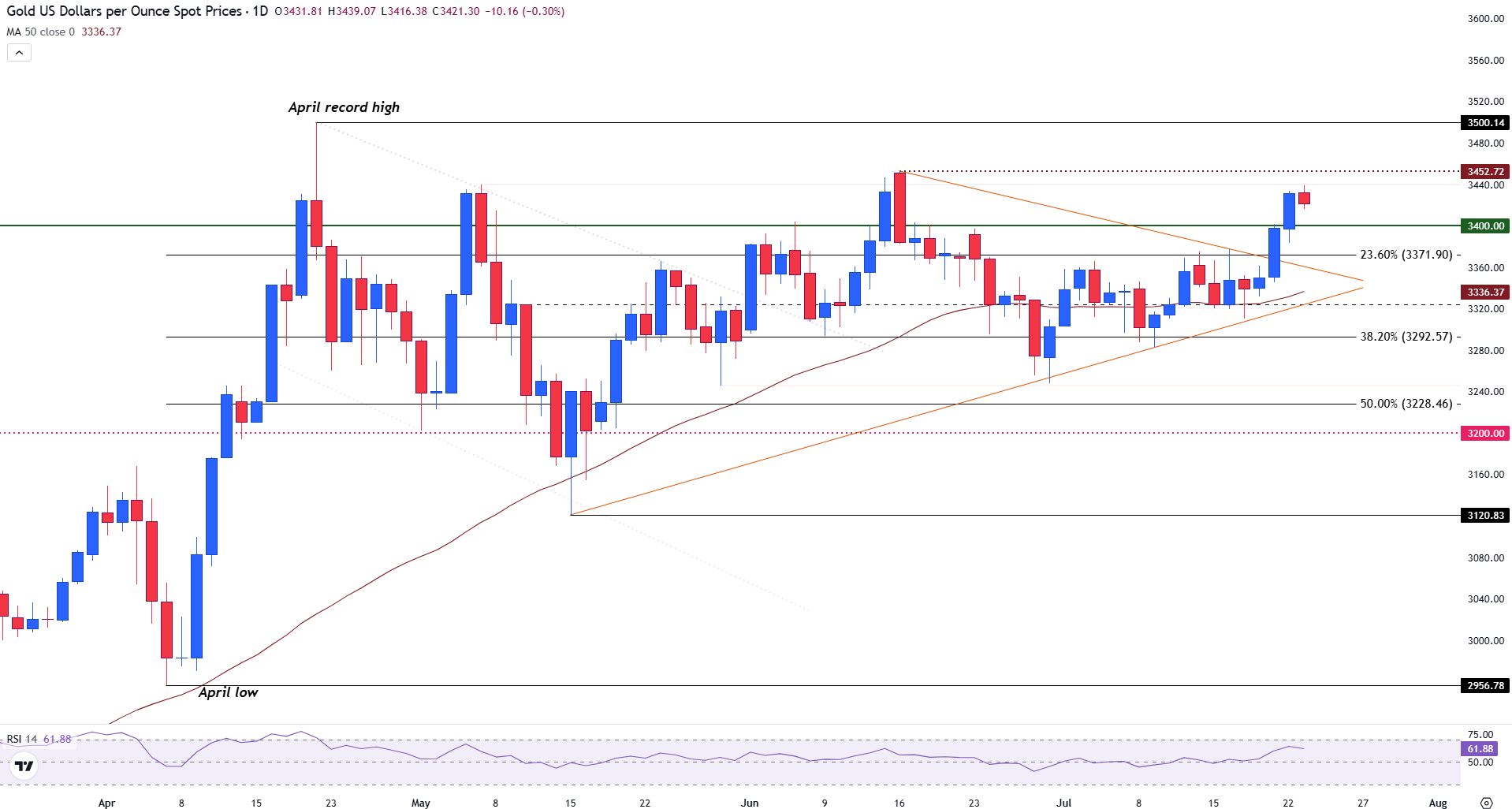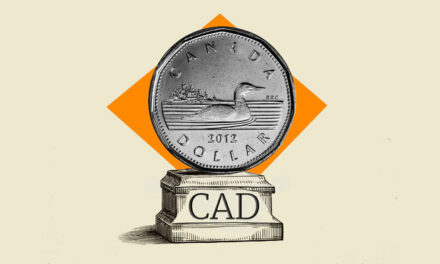- Gold retreats as US-Japan deal lifts risk sentiment ahead of the August tariff deadline.
- US Dollar attempts a recovery, but concerns surrounding Fed policy and unresolved trade disputes remain.
- XAU/USD holds above $3,400 as bulls get rejected after testing five-week high.
Gold is undergoing a modest pullback on Wednesday, as markets assess the implications of a United States (US)–Japan trade agreement and remain cautious ahead of further developments in the European Union (EU)–US negotiations.
Despite the correction, XAU/USD is holding above the $3,400 mark, supported by lingering tariff risks and broader policy uncertainty.
US President Donald Trump announced on Wednesday that a “massive deal” had been reached with Japan, outlining key terms in a Truth Social post.
The agreement includes a reduced 15% reciprocal tariff on Japanese goods, down from a proposed 25%. The deal is also expected to entail plans for $550 billion in Japanese investment and expanded US access to Japan’s agricultural and automotive markets.
The deal has helped calm some trade-related fears, reducing short-term safe-haven flows into Gold.
However, underlying support for gold remains intact. Markets remain wary of unresolved trade tensions, ahead of the August 1 tariff deadline and ongoing questions around Fed independence.
Daily digest market movers: Gold retains its appeal amid ongoing Fed uncertainty and unresolved tariff risks
- Existing Home Sales data released on Wednesday reflected a decline in the estimated value of the housing market. The recent data showed that US existing home sales fell to an annualized rate of 3.93 million in June. These figures were below the 4.01 million forecast, representing a 2.7% monthly decline, a potential sign that high mortgage rates and affordability issues may be filtering through to the housing market.
- At the same time, EU-US trade talks remain unresolved, with less than two weeks until the August 1 tariff deadline. If no agreement is reached, the US may impose broad-based tariffs of up to 30% on EU imports. This has prompted the European Union to prepare retaliatory measures targeting key US exports, including digital services and aerospace products.
- Apart from trade talks, policy uncertainty and mounting pressure on the Federal Reserve (Fed) to cut rates have put pressure on Yields, limiting gains in the US Dollar. US President Trump has consistently and very publicly called for the Fed to dramatically lower interest rates, often stating they should be at 1% or even lower.
- In a meeting with Philippine President Ferdinand Marcos on Tuesday, Trump stated that Powell has “done a bad job, but he’s going to be out pretty soon.” Comments from Treasury Secretary Scott Bessent also suggested that it might be time to “examine the entire institution and whether they’ve been successful.” He proposed a framework for the Fed’s non-monetary functions due to concerns over “mission creep” and building renovation overruns.
- Some critics also point to the Fed’s practice of paying interest on bank reserves as a “perverse” structure that subsidizes banks and has led to the Fed operating at a loss.
- With the Fed currently in a blackout period ahead of the July 30 rate decision, criticism from Trump and concerns surrounding Fed Independence have enhanced the appeal of Gold.
Gold technical analysis: XAU/USD consolidates near five-week highs, holds firm above $3,400
Gold (XAU/USD) is currently trading near $3,412 at the time of writing, retreating modestly from its five-week intraday high of $3,439. Despite the pullback, the metal remains well supported above the psychological $3,400 level, following a breakout from a multi-week ascending triangle formation.
The Relative Strength Index (RSI) is currently hovering around 63 on the daily chart, indicating that momentum remains positive but is not yet overbought.
If bulls maintain control, a retest of the June swing high of $3,452 appears likely, with potential for further upside toward the all-time high and psychological $3,500 level.
On the downside, immediate support is seen at the $3,400 round level, followed by the 23.6% Fibonacci retracement of the April low-high move at $3,371 and the 50-day SMA at $3,336. A break below the triangle apex and the 38.2% Fibonacci level at $3,292 would invalidate the near-term bullish structure.

Gold daily chart
Tariffs FAQs
Tariffs are customs duties levied on certain merchandise imports or a category of products. Tariffs are designed to help local producers and manufacturers be more competitive in the market by providing a price advantage over similar goods that can be imported. Tariffs are widely used as tools of protectionism, along with trade barriers and import quotas.
Although tariffs and taxes both generate government revenue to fund public goods and services, they have several distinctions. Tariffs are prepaid at the port of entry, while taxes are paid at the time of purchase. Taxes are imposed on individual taxpayers and businesses, while tariffs are paid by importers.
There are two schools of thought among economists regarding the usage of tariffs. While some argue that tariffs are necessary to protect domestic industries and address trade imbalances, others see them as a harmful tool that could potentially drive prices higher over the long term and lead to a damaging trade war by encouraging tit-for-tat tariffs.
During the run-up to the presidential election in November 2024, Donald Trump made it clear that he intends to use tariffs to support the US economy and American producers. In 2024, Mexico, China and Canada accounted for 42% of total US imports. In this period, Mexico stood out as the top exporter with $466.6 billion, according to the US Census Bureau. Hence, Trump wants to focus on these three nations when imposing tariffs. He also plans to use the revenue generated through tariffs to lower personal income taxes.







